-
REFLECTION01-01-2017
Theory of communicative action: a basis for the development of critical thinking
Revista Brasileira de Enfermagem. 2017;70(6):1343-1346
Abstract
REFLECTIONTheory of communicative action: a basis for the development of critical thinking
Revista Brasileira de Enfermagem. 2017;70(6):1343-1346
DOI 10.1590/0034-7167-2016-0383
Views0See moreABSTRACT
Reflections on some assumptions of the theory of Communicative Action and the development of Critical Thinking in the context of training students in undergraduate nursing courses. The perspective is based on concepts of Jürgen Habermas, as a possibility for the development of critical thinking among the students of these courses. Communication is therefore understood as inherent in the training of nurses in a continuous, dynamic, dialogical process, with interventions that are related to the context of the students and that have meaning for them, in order to contribute to the promotion of Critical Thinking.
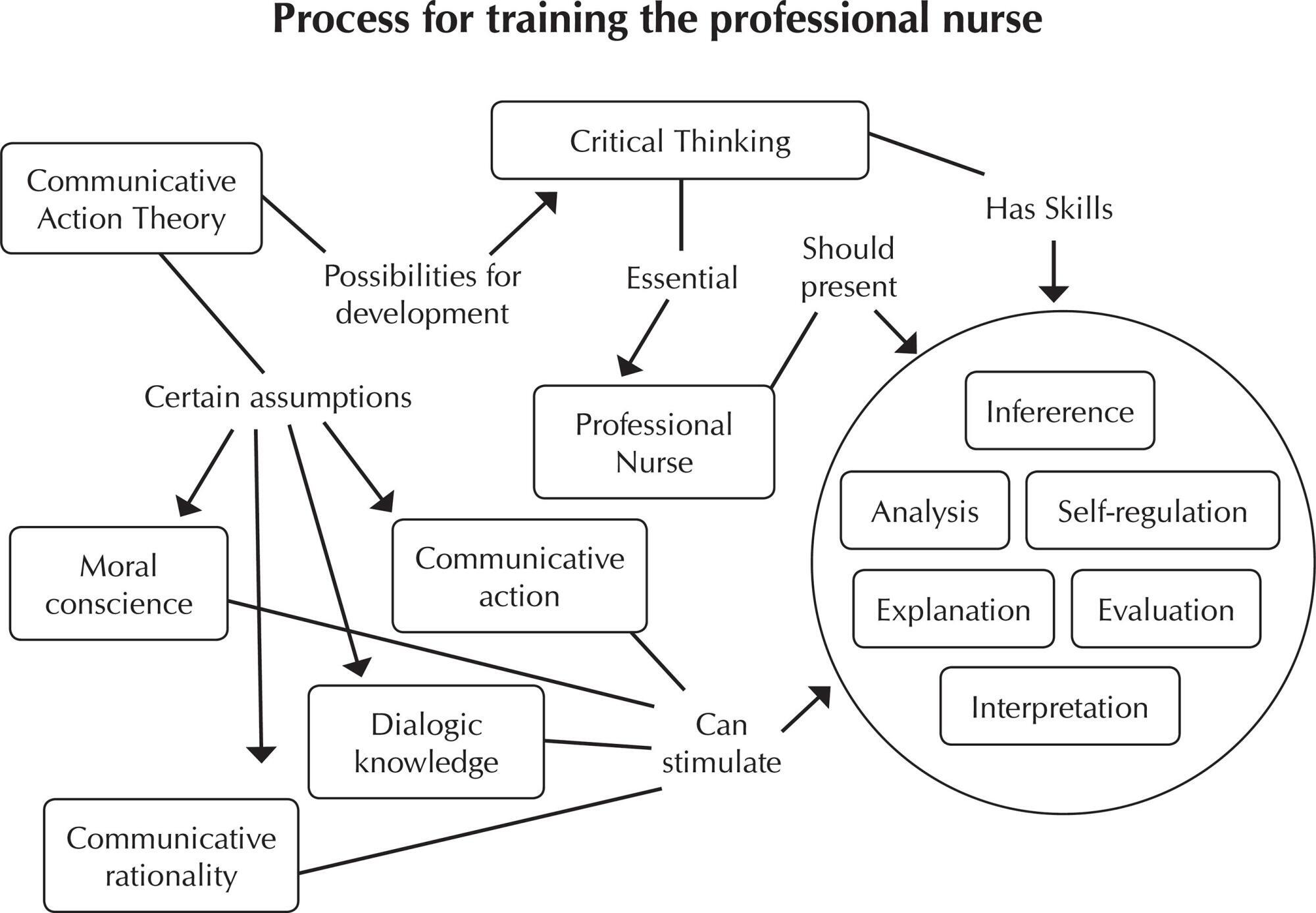
-
REFLECTION01-01-2017
Bath for dependent patients: theorizing aspects of nursing care in rehabilitation
Revista Brasileira de Enfermagem. 2017;70(6):1337-1342
Abstract
REFLECTIONBath for dependent patients: theorizing aspects of nursing care in rehabilitation
Revista Brasileira de Enfermagem. 2017;70(6):1337-1342
DOI 10.1590/0034-7167-2016-0258
Views0See moreABSTRACT
Objective:
to produce a reflective essay on what has been produced in relation to bath as a procedure related to nursing care and diagnosis for dependent patients undergoing mediate and immediate rehabilitation processes after a traumatic event.
Method:
discursive, reflective study supported by classical content analysis consisting of the following stages: a) reading of the texts in their most comprehensive form; b) emphasizing the relevant elements produced about bathing; c) reflection on texts and what is produced about bathing.
Results:
the texts point out to three categories for nursing practice and reflection: Meaning to patients on the purposes of bathing; Representation for nurses in the work process; Representation for nurses in the management of care and nursing care planning.
Conclusion:
the reflection points out understandings on bathing as a care focused on the autonomy of nursing rehabilitation patients, requiring further investigations.

-
REVIEW01-01-2017
Clinical indicators for nursing diagnosis Ineffective protection in adolescents with cancer
Revista Brasileira de Enfermagem. 2017;70(6):1330-1336
Abstract
REVIEWClinical indicators for nursing diagnosis Ineffective protection in adolescents with cancer
Revista Brasileira de Enfermagem. 2017;70(6):1330-1336
DOI 10.1590/0034-7167-2016-0571
Views0See moreABSTRACT
Objective:
To investigate scientific evidence related to the term protection and clinical indicators and etiologic factors for nursing diagnosis Ineffective protection in adolescents with cancer.
Method:
Integrative literature review in the databases of Scopus, Web of Science, National Library of Medicine and National Institutes of Health (PubMed) and Cochrane; by intersection of the descriptors protection and childhood cancer, which resulted in seven articles. These were insufficient for a comprehension of the term protection and aspects related to its impairment, therefore it was necessary to include a further three reference books.
Results:
Five clinical indicators and three etiologic factors associated to Ineffective protection were identified some of which were not cited in NANDA-International.
Conclusions:
There are clinical and etiologic factors important for the identification of ineffective protection in adolescents with cancer.
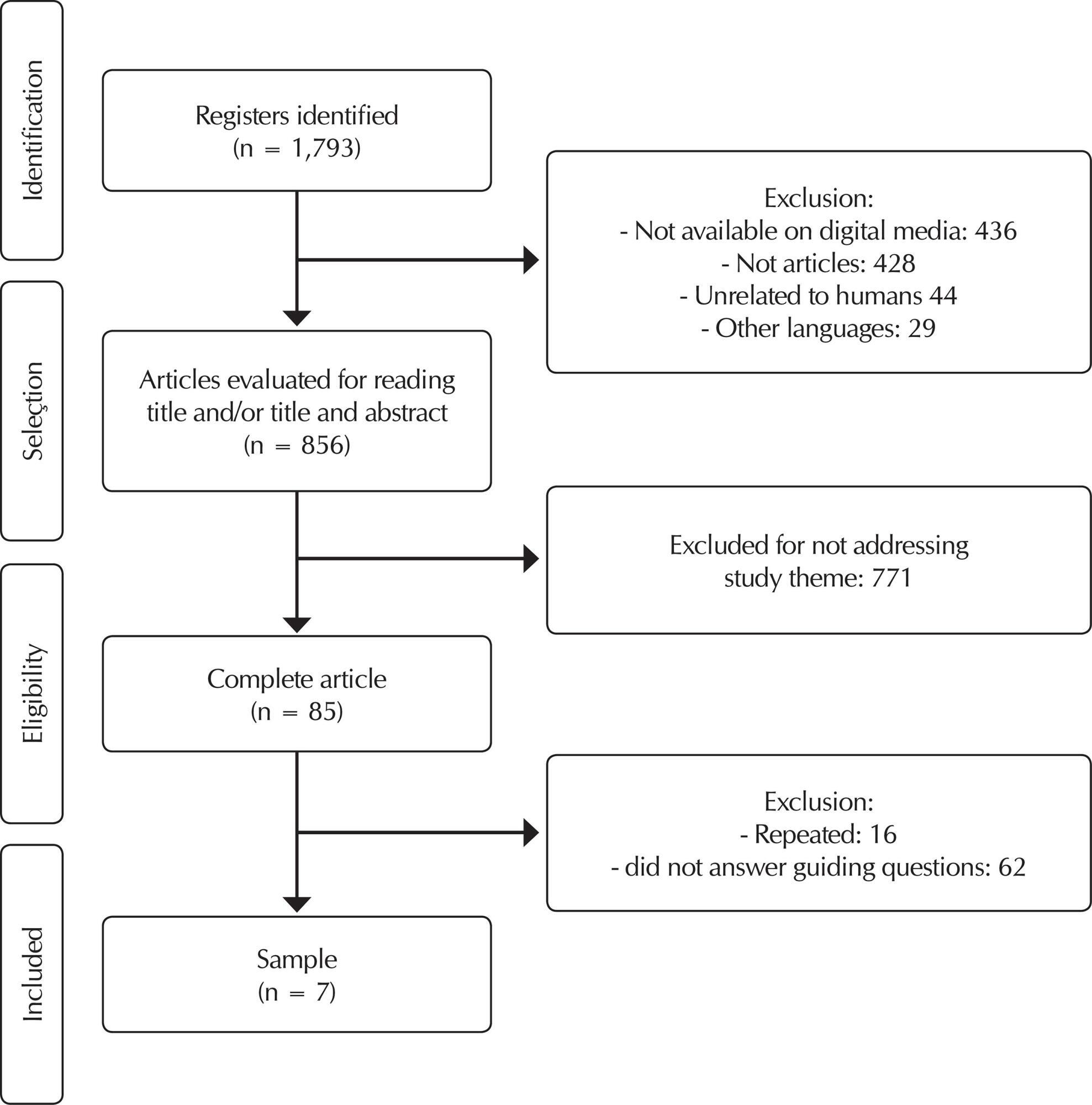
-
REVIEW01-01-2017
Supported self-care for children and adolescents with chronic disease and their families
Revista Brasileira de Enfermagem. 2017;70(6):1318-1329
Abstract
REVIEWSupported self-care for children and adolescents with chronic disease and their families
Revista Brasileira de Enfermagem. 2017;70(6):1318-1329
DOI 10.1590/0034-7167-2016-0553
Views0See moreABSTRACT
Objective:
analyze the scientific production between 2006 and 2015 on strategies for supported self-care by children and adolescents with chronic disease and their families.
Method:
integrative review of the literature conducted July and August 2016 in the databases: BDENF, LILACS, IBECS, ADOLEC, MEDLINE/PubMed and SCIELO. The 27 selected studies were analyzed and categorized into the five pillars of supported self-care: evaluation, counseling, agreement, care and accompaniment.
Results:
only two studies covered all five pillars, evaluation was considered most, but accompaniment was essential for adherence to the therapeutics of the goal plan. There was a prevalence of actions to evaluate the emotional state of the child/adolescent/family and technological interventions to empower the individual in self-care.
Final considerations:
these actions are concentrated in countries with health systems directed to the health needs of people with chronic disease. In Brazil, this is still incipient, since the actions are focused on exacerbation.
-
REVIEW01-01-2017
Systemic Arterial Hypertension in people living with HIV/AIDS: integrative review
Revista Brasileira de Enfermagem. 2017;70(6):1309-1317
Abstract
REVIEWSystemic Arterial Hypertension in people living with HIV/AIDS: integrative review
Revista Brasileira de Enfermagem. 2017;70(6):1309-1317
DOI 10.1590/0034-7167-2016-0416
Views0See moreABSTRACT
Objective:
To analyze scientific productions about the relationship between HIV and Systemic Arterial Hypertension (SAH) in people living with HIV/AIDS (PLWHA).
Method:
Integrative literature review in six databases, held in March 2016. “AIDS” and “hypertension” were the keywords used in Portuguese, English and Spanish languages. We found 248 articles and selected 17. The categories formulated were “prevalence of SAH in PLWHA,” “risk factors for SAH in PLWHA” and “adverse events of antiretroviral therapy (ART) that contribute to HAS.”
Results:
There is no consensus whether HIV and ART influence the SAH development, but there are several risk factors for SAH among PLWHA. It was observed that protease inhibitors medicines influence SAH the most.
Conclusion:
Guidelines for SAH prevention must be performed in all individuals, however, in PLWHA, they must focus on characteristic risk factors of this population.

-
REVIEW01-01-2017
Managing febrile neutropenia in adult cancer patients: an integrative review of the literature
Revista Brasileira de Enfermagem. 2017;70(6):1301-1308
Abstract
REVIEWManaging febrile neutropenia in adult cancer patients: an integrative review of the literature
Revista Brasileira de Enfermagem. 2017;70(6):1301-1308
DOI 10.1590/0034-7167-2016-0247
Views0See moreABSTRACT
Objective:
To analyze the interventions performed by health professionals with a view to managing chemotherapy-induced febrile neutropenia.
Method:
Integrative literature review, the sample of 12 primary articles was selected from the following databases: LILACS, SciELO, BVS, PubMed, CINAHL and Web of Science.
Results:
There was a prevalence of studies, realized by doctors, focused on pharmacological treatment and on the association of methods for greater diagnostic accuracy of febrile neutropenia. A study was found on pharmaceutical management regarding antibiotic dosing efficacy and a study indicating that nurses could contribute to the identification of elderly patients who would benefit from prophylactic use of growth factor.
Conclusion:
There was a shortage of studies involving the participation of other health professionals, besides the doctors, and a knowledge gap regarding interprofessional practice in the management of interventions specific to their area of specialism, joint interventions and non-pharmacological interventions.

-
CASE STUDY01-01-2017
Neonatal appendicitis: a survival case study
Revista Brasileira de Enfermagem. 2017;70(6):1296-1300
Abstract
CASE STUDYNeonatal appendicitis: a survival case study
Revista Brasileira de Enfermagem. 2017;70(6):1296-1300
DOI 10.1590/0034-7167-2016-0610
Views0See moreABSTRACT
Objective:
To report a case of neonatal appendicitis in a children’s hospital in southern Brazil, demonstrating the impact on neonatal survival.
Method:
Case study with data collection from medical records, approved by the Institution and Ethics Committee for Research with Human Beings.
Results:
The clinical picture is initially characterized by food intolerance, evolving to hypoactivity, alteration of vital signs and septicemia due to intestinal perforation. Management is exclusively surgical, since no case described in the literature was diagnosed preoperatively and the findings usually point to acute abdomen.
Conclusion:
A focused clinical surveillance should be established when the infant presents peritoneal irritation. Follow-up of the evolution and the worsening of the symptoms by nurses, as part of the care team in partnership with the medical team, enables an early surgical intervention, thereby avoiding complications such as septicemia and death.
-
CASE STUDY01-01-2017
Use of virtual reality for treating burned children: case reports
Revista Brasileira de Enfermagem. 2017;70(6):1291-1295
Abstract
CASE STUDYUse of virtual reality for treating burned children: case reports
Revista Brasileira de Enfermagem. 2017;70(6):1291-1295
DOI 10.1590/0034-7167-2016-0575
Views0See moreABSTRACT
Objective:
To report the use of virtual reality (VR) in pain intensity during dressing change of two burned children hospitalized in a Burn Treatment Center (BTC) in Southern Brazil.
Method:
Case report on the use of VR during dressing change of two burned children hospitalized in a BTC, from May to July 2016. For assessing pain, a facial pain rating scale was applied at four times: just before the dressing, during the dressing without the use of VR, during the dressing with the VR, and after the use of VR.
Results:
The use of goggles was easy to apply and well-accepted by the children, and also had a relevant effect reducing pain.
Conclusion:
VR can become an important nonpharmacological method for treating pain in burned children.

-
ORIGINAL ARTICLE12-08-2023
Simulation-based training in Leprosy: development and validation of a scenario for community health workers
Revista Brasileira de Enfermagem. 2023;76:e20230114
Abstract
ORIGINAL ARTICLESimulation-based training in Leprosy: development and validation of a scenario for community health workers
Revista Brasileira de Enfermagem. 2023;76:e20230114
DOI 10.1590/0034-7167-2023-0114
Views0See moreABSTRACT
Objectives:
To build and validate a clinical simulation scenario designed to instruct community health workers (CHWs) in active leprosy case detection.
Methods:
Methodological study involving the development of a simulated clinical scenario and content validation by experts. The Content Validity Index (CVI) was used to determine the level of agreement among the judging commitee, and a descriptive analysis of their recommendations was performed.
Results:
A simulated scenario with a simulated participant was developed — a simulation characterized by low complexity, moderate physical/environmental fidelity, moderate to high psychological fidelity, and high conceptual fidelity, lasting 50 minutes and capable of training up to 10 CHWs simultaneously. The scenario was validated by 14 experts, with a CVI exceeding 80% for all components.
Conclusions:
The validated clinical simulation possesses attributes that make it highly reproducible in various national health contexts, thereby contributing to the global “Towards Zero Leprosy” strategy.
-
ORIGINAL ARTICLE12-08-2023
Knowledge and practices about health among Quilombola men: contributions to health care
Revista Brasileira de Enfermagem. 2023;76:e20230138
Abstract
ORIGINAL ARTICLEKnowledge and practices about health among Quilombola men: contributions to health care
Revista Brasileira de Enfermagem. 2023;76:e20230138
DOI 10.1590/0034-7167-2023-0138
Views1See moreABSTRACT
Objective:
to analyze health knowledge and practices among Quilombola men.
Methods:
a qualitative, descriptive study, carried out with 40 men from two Quilombola communities in Santa Izabel do Pará, state of Pará, Brazil. Individual interviews were carried out using a semi-structured script. Text corpus was subjected to analysis with Interface de R pour les Analyses Multidimensionnelles de Textes et de Questionnaires 0.6, alpha 3, through Descending Hierarchical Classification.
Results:
among participants, eight (20.00%) were aged 55 to 59 years. 382 text segments were identified, with 299 (78.27%) being used, generating five lexical classes, which made up two subcorpora. The classes were organized into four thematic axes, covering knowledge about health and practices to prevent and solve health problems.
Final considerations:
men highlighted popular/traditional wisdom permeated by biomedical knowledge, translating their understanding of how to act to remain or become healthy.
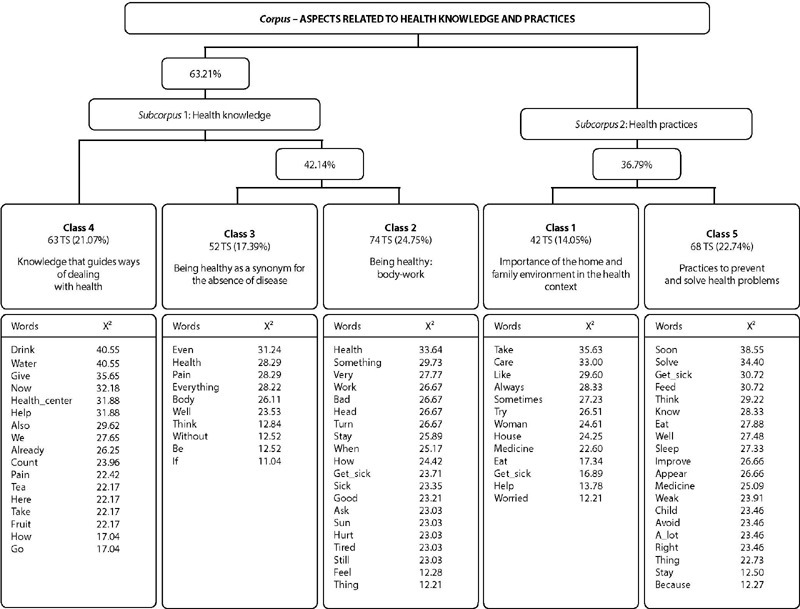
-
ORIGINAL ARTICLE10-06-2023
Ethical problems in nursing teleconsultations for people living with HIV during the Covid-19 pandemic
Revista Brasileira de Enfermagem. 2023;76:e20220754
Abstract
ORIGINAL ARTICLEEthical problems in nursing teleconsultations for people living with HIV during the Covid-19 pandemic
Revista Brasileira de Enfermagem. 2023;76:e20220754
DOI 10.1590/0034-7167-2022-0754
Views0See moreABSTRACT
Objectives:
to understand the ethical problems experienced by primary health care nurses in using nursing teleconsultations for people living with the human immunodeficiency virus during the coronavirus pandemic.
Methods:
qualitative research, anchored in Constructivist Grounded Theory. Data was collected between July and September 2020, with 17 participants.
Results:
the first category highlights the ethical problems in conducting teleconsultations, managing high demand, communication barriers, and risks related to data security. The second emphasizes the potential of teleconsultations in communication and access, by generating changes in the work process and the use of protocols to guide clinical practice.
Conclusions:
nurses’ work in digital mode requires professional qualification, with a view to stimulating reflection on teleconsultation practice, ethical-moral deliberation and combating stigma, and also adopting data security-centered conduct.
-
12-04-2023
Ethical dilemmas at the end of life: a reflection from the Philosophical Perspective of Luigina Mortari
Revista Brasileira de Enfermagem. 2023;76:e20220759
Abstract
Ethical dilemmas at the end of life: a reflection from the Philosophical Perspective of Luigina Mortari
Revista Brasileira de Enfermagem. 2023;76:e20220759
DOI 10.1590/0034-7167-2022-0759
Views0See moreABSTRACT
Objectives:
to reflect on the ethical dilemmas involved in the care of patients at the end of their lives.
Methods:
this is a theoretical-reflective study based on the ethics of care proposed by Luigina Mortari.
Results:
discussing care involves addressing the ways of being inherent to human existence and understanding the unique characteristics of this condition. Ethical care constitutes an action driven by interest in the other and by the perception of their need. Ethical dilemmas are a part of end-of-life care, making it essential to maintain respectful assistance that considers the patient’s autonomy, using strategies for expressing their wishes, and ensuring continuous clear and empathetic communication among all those involved in providing care.
Final Considerations:
issues related to being, stemming from one’s reality of dependency and vulnerability, contribute to the emergence of ethical dilemmas present in care actions.
-
ORIGINAL ARTICLE12-04-2023
Overview of nursing ethics teaching in Brazilian public higher education institutions
Revista Brasileira de Enfermagem. 2023;76:e20220808
Abstract
ORIGINAL ARTICLEOverview of nursing ethics teaching in Brazilian public higher education institutions
Revista Brasileira de Enfermagem. 2023;76:e20220808
DOI 10.1590/0034-7167-2022-0808
Views0See moreABSTRACT
Objectives:
to outline the teaching of ethics in undergraduate Nursing programs in Brazilian public higher education institutions.
Methods:
descriptive and exploratory study, carried out through the documentary analysis of pedagogical projects of undergraduate Nursing programs in Brazil.
Results:
153 active undergraduate Nursing programs were found, of which 106 provide the pedagogical project. In addition to deontological teaching, the teaching of ethics was identified in a transversal way associated with themes such as Social Context, Hospital and Community Care, Pharmacology, Systematization of Nursing Care, Surgical Nursing, Epidemiology, Palliative Care, Management in Nursing, Diversity, Women’s, Children’s, Adolescent’s, Adult’s and Older People’s Health, and Mental Health.
Final Considerations:
the challenge in teaching nursing ethics is its integration with each action of caring, teaching and managing.
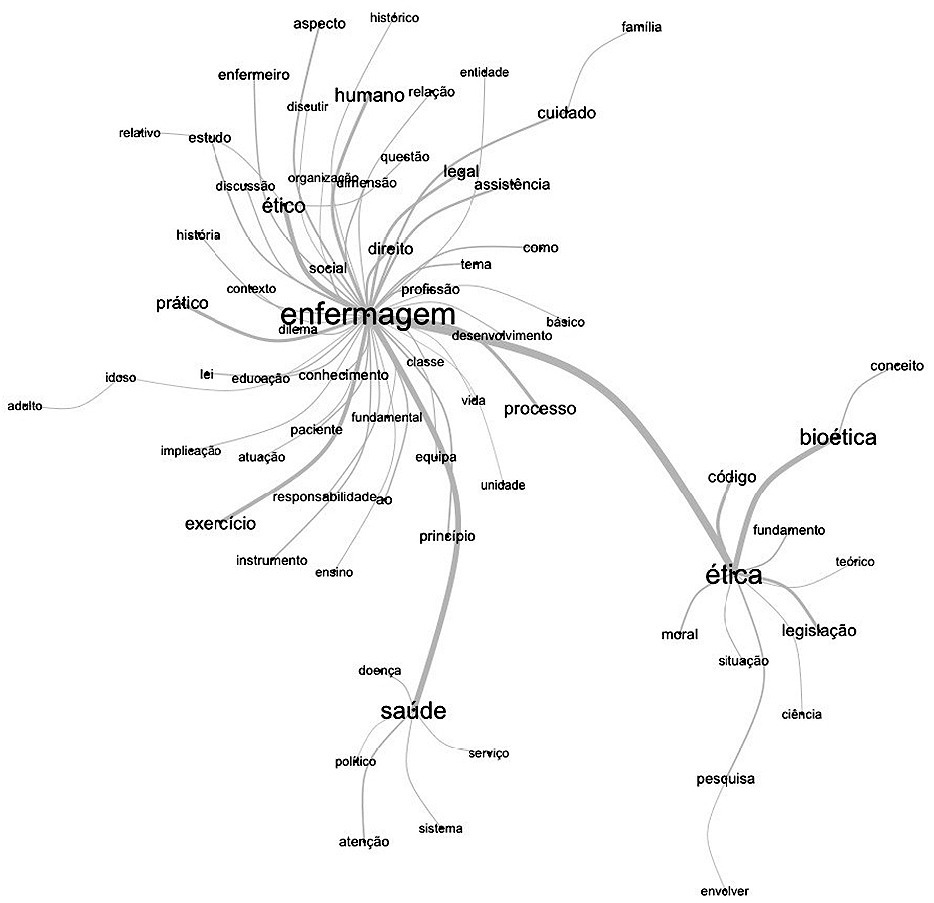
-
ORIGINAL ARTICLE12-08-2023
Validation of telesimulation in the care of late preterm newborns with hypoglycemia for nursing students
Revista Brasileira de Enfermagem. 2023;76:20220438
Abstract
ORIGINAL ARTICLEValidation of telesimulation in the care of late preterm newborns with hypoglycemia for nursing students
Revista Brasileira de Enfermagem. 2023;76:20220438
DOI 10.1590/0034-7167-2022-0438
Views0See moreABSTRACT
Objective:
To develop and validate a telesimulation scenario for nursing students in the care of late preterm infants with hypoglycemia.
Methods:
A methodological study conducted between August 2021 and May 2022 in a virtual environment involved constructing and validating the scenario with 10 experts, and testing it with 10 students. The content validity index assessed validity, with a threshold of 80% or higher, and suggestions were analyzed using semantic approximation.
Results:
Validation confirmed the appropriateness of all 14 scenario items, with an overall index of 97.8% and clarity and relevance indices of 98.5%. During testing, the overall index was 99.7%, with the “resources” item receiving the lowest score. Adjustments were made to objectives, technical terms, resources, and target audience based on feedback.
Conclusion:
Telesimulation is a widely accepted educational technology for training nursing students, with potential to enhance teaching quality and neonatal care.
-
ORIGINAL ARTICLE11-10-2023
Construction and validity of educational technology in audiovisual media on premature newborn care
Revista Brasileira de Enfermagem. 2023;76:e20220403
Abstract
ORIGINAL ARTICLEConstruction and validity of educational technology in audiovisual media on premature newborn care
Revista Brasileira de Enfermagem. 2023;76:e20220403
DOI 10.1590/0034-7167-2022-0403
Views0See moreABSTRACT
Objectives:
to construct and validate an educational video storyboard about care for premature newborns at home.
Methods:
a methodological study, with the construction of an educational video storyboard, validated with 14 judges. Content was selected from scoping review. For data collection, a validated instrument was used. The criterion for validity was agreement greater than 80%, analyzed using the Content Validity Index.
Results:
the storyboard construction was guided by the Cognitive Theory of Multimedia Learning theoretical framework. Construction and validity took place from May to December 2020. The storyboard’s final version lasted 10 minutes, and was validated in terms of objective, structure, presentation and relevance, with a Content Validity Index of 0.9.
Conclusions:
the storyboard of the educational video proved to be valid and adequate for health promotion in developing care for premature newborns at home.

-
ORIGINAL ARTICLE12-08-2023
Early ambulation and dhikr complementary therapies effect on intestinal peristaltic in post-open cholecystectomy patients
Revista Brasileira de Enfermagem. 2023;76:e20220636
Abstract
ORIGINAL ARTICLEEarly ambulation and dhikr complementary therapies effect on intestinal peristaltic in post-open cholecystectomy patients
Revista Brasileira de Enfermagem. 2023;76:e20220636
DOI 10.1590/0034-7167-2022-0636
Views0ABSTRACT
Objectives:
to analyze and determine the effect of a combination intervention of early ambulation and dhikr therapy on intestinal peristaltic recovery in post-open cholecystectomy patients.
Methods:
a pre-experimental design with one group pre and post-test design was used. The samples were 15 post-open cholecystectomy patients which were selected using the purposive sampling technique. The data were collected using the instrument observation sheet and analyzed using the Wilcoxon test. Early ambulation used standard operational procedure in the hospital and dhikr therapy was carried out at 2 hours post-operation for 10-15 minutes.
Results:
there was an effect of early ambulation and dhikr therapy on intestinal peristaltic recovery in post-open cholecystectomy patients with general anesthesia (Z=-3.442; p=0.001).
Conclusions:
a combination of early ambulation and dhikr therapy can be recommended as interventions to improve intestinal peristaltic in a post-open cholecystectomy patient with general anesthesia.
Keywords:Anesthesia, GeneralCholecystectomyComplementary TherapiesEarly AmbulationPerioperative NursingSee more
-
ORIGINAL ARTICLE09-21-2020
Nurses’ attitudes facing the family involvment in caring for people with mental disorder
Revista Brasileira de Enfermagem. 2020;73:e20200041
Abstract
ORIGINAL ARTICLENurses’ attitudes facing the family involvment in caring for people with mental disorder
Revista Brasileira de Enfermagem. 2020;73:e20200041
DOI 10.1590/0034-7167-2020-0041
Views0See moreABSTRACT
Objective:
To characterize the attitudes of Primary Health Care nurses, regarding the involvement of the family in the care for people with Mental Disorder.
Methods:
Correlational study with 257 nurses from the city of São Paulo. The scale “Importance of Families in Nursing Care- Nurses’ Attitudes” was used. For the analysis, descriptive and inferential statistics were used.
Results:
The scale scores were high, with a mean value of 82.1 (SD=8.4) favorable to the families’ involvement, and are related to being a nurse in the Family Health Strategy (p<0.001), having received education/training in family nursing (p<0.005), the workload of 40 hours/week (p<0.005), working in the West, East and Center Regions (p<0.005).
Conclusion:
Most nurses have positive attitudes towards the involvement of families, a relevant indicator for their inclusion in the health-mental care process.
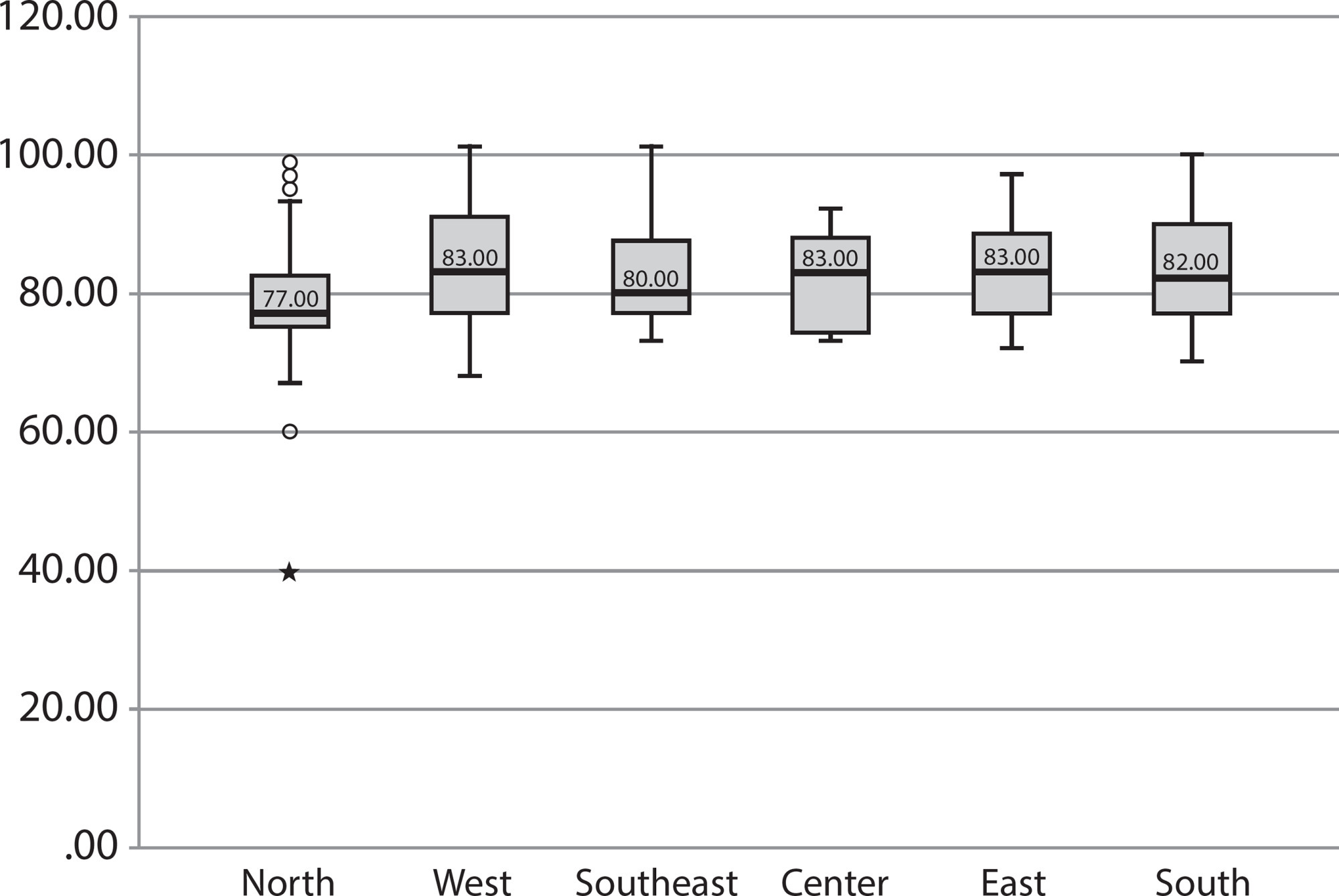
-
ORIGINAL ARTICLE02-10-2020
Night Admission at a Psychosocial Care Center III
Revista Brasileira de Enfermagem. 2020;73(1):e20170964
Abstract
ORIGINAL ARTICLENight Admission at a Psychosocial Care Center III
Revista Brasileira de Enfermagem. 2020;73(1):e20170964
DOI 10.1590/0034-7167-2017-0964
Views0See moreABSTRACT
Objective:
to analyze night admission characteristics at a Psychosocial Care Center III (CAPS III – Centro de Atenção Psicossocial).
Method:
a qualitative research, whose data were collected with 15 nursing professionals from November to April 2016, through a semi-structured interview.
Results:
it was verified that night admission is provided by the nursing team in different dynamics from the day care. This team has strategies of care during crisis, avoiding search for other network services and maintaining the CAPS in its function within the psychosocial model.
Final considerations:
service operation depends on the nursing team for its permanence condition in all shifts, which leads to the need to think about the legislation reformulation that structures the CAPS III team, in order to guarantee the interdisciplinary care provided by the Brazilian Psychiatric Reform in this device, which should replace hospitalization in a specialized institution.
-
CASE STUDY08-19-2019
Decision making from the perspective of nursing students
Revista Brasileira de Enfermagem. 2019;72(4):1102-1108
Abstract
CASE STUDYDecision making from the perspective of nursing students
Revista Brasileira de Enfermagem. 2019;72(4):1102-1108
DOI 10.1590/0034-7167-2018-0311
Views0See moreABSTRACT
Objective:
To analyze the decision making of students from a nursing higher school and understand how they make decisions in the care process.
Method:
A qualitative study with an exploratory and descriptive approach was carried out with the case study method.
Results:
Six types of decision making were categorized by the students as follows: Decision about communication (15 record units [RU]); Decision about understanding (14 RU); Decision about intervention (9 RU); Decision about timing (5 RU); Decision about targeting (4 RU); and Decision about management (0 RU), with a total of 47 RU.
Final considerations:
Analysis of the learning diaries showed that students make more decisions regarding communication with patients and understanding of the care situation, than with the acting decision.
-
ORIGINAL ARTICLE12-21-2020
Nurses’ work at Family Health Strategy: possibilities to operate health needs
Revista Brasileira de Enfermagem. 2020;73:e20190704
Abstract
ORIGINAL ARTICLENurses’ work at Family Health Strategy: possibilities to operate health needs
Revista Brasileira de Enfermagem. 2020;73:e20190704
DOI 10.1590/0034-7167-2019-0704
Views0See moreABSTRACT
Objectives:
to identify and analyze possibilities for recognizing health needs in the nurses’ work at Family Health Strategy.
Methods:
a qualitative study with interviews and observation of the nurses’ work in the countryside of São Paulo. The empirical material was subjected to thematic content analysis and interpreted in the light of the health work process.
Results:
two themes emerged: Possibilities utilized and Possibilities neglected to recognize health needs. Careful observation, welcoming, attention, listening, bonding and dialogue developed by nurses, in live work in action with users, touched on the possibilities, which, taken advantage of, were evidenced in care in spontaneous demand, scheduled consultation, examination gynecological and group activities.
Final Considerations:
nurses are able to recognize health needs, which can expand their clinical practice and interprofessionality in Family Health.
-
ORIGINAL ARTICLE08-19-2019
Social Determinants of Health and their influence on the choice of birth control methods
Revista Brasileira de Enfermagem. 2019;72(4):1044-1051
Abstract
ORIGINAL ARTICLESocial Determinants of Health and their influence on the choice of birth control methods
Revista Brasileira de Enfermagem. 2019;72(4):1044-1051
DOI 10.1590/0034-7167-2017-0574
Views0See moreABSTRACT
Objective:
To verify the association between Social Determinants of Health and birth control methods used by women of childbearing age.
Methods:
Documentary and retrospective study, performed at a Brazilian Natural Birth Center with evaluation of the medical records of patients seen between 2003 and 2011 (n=2410). Data were collected on identification and general history, gynecological, sexual and obstetric.
Results:
Hormone birth control methods were the most used among participants (25.0%); followed by barrier methods (21.5%) and surgical methods (19.3%). Statistical associations were observed regarding age, menarche, onset of sexual activity, pregnancy, miscarriage, smoking, hypertension, marital status, gynecological care and schooling with the choice of methods.
Conclusion:
The results confirm the importance of studies involving Social Determinants of Health, since they interfere in the way women choose birth control methods and the risks that this choice may pose to their health.
-
REVIEW07-13-2020
Augmentative and Alternative Communication in Ventilated Patients: A Scoping Review
Revista Brasileira de Enfermagem. 2020;73(5):e20190562
Abstract
REVIEWAugmentative and Alternative Communication in Ventilated Patients: A Scoping Review
Revista Brasileira de Enfermagem. 2020;73(5):e20190562
DOI 10.1590/0034-7167-2019-0562
Views0See moreABSTRACT
Objectives:
to map the benefits of Augmentative and Alternative Communication in ventilated adults in Intensive Care Unit and identify strategies used.
Methods:
a Scoping Review was carried out according to the Joanna Brigs Institute Protocol. The research question was: “In adult patients ventilated in Intensive Care Units, what are the benefits of Augmentative and Alternative Communication?”. An article research was carried out at PubMed, EBSCOhost and B-On databases. It was held between October and November 2018, from 2013 to 2018, in Portuguese and in English.
Results:
61 references were obtained. After selection according to the inclusion criteria, 7 articles were analyzed.
Conclusions:
studies enunciate Augmentative and Alternative Communication as a strategy to enhance communication, describing methods and tools. There is no agreement on the most effective tool.
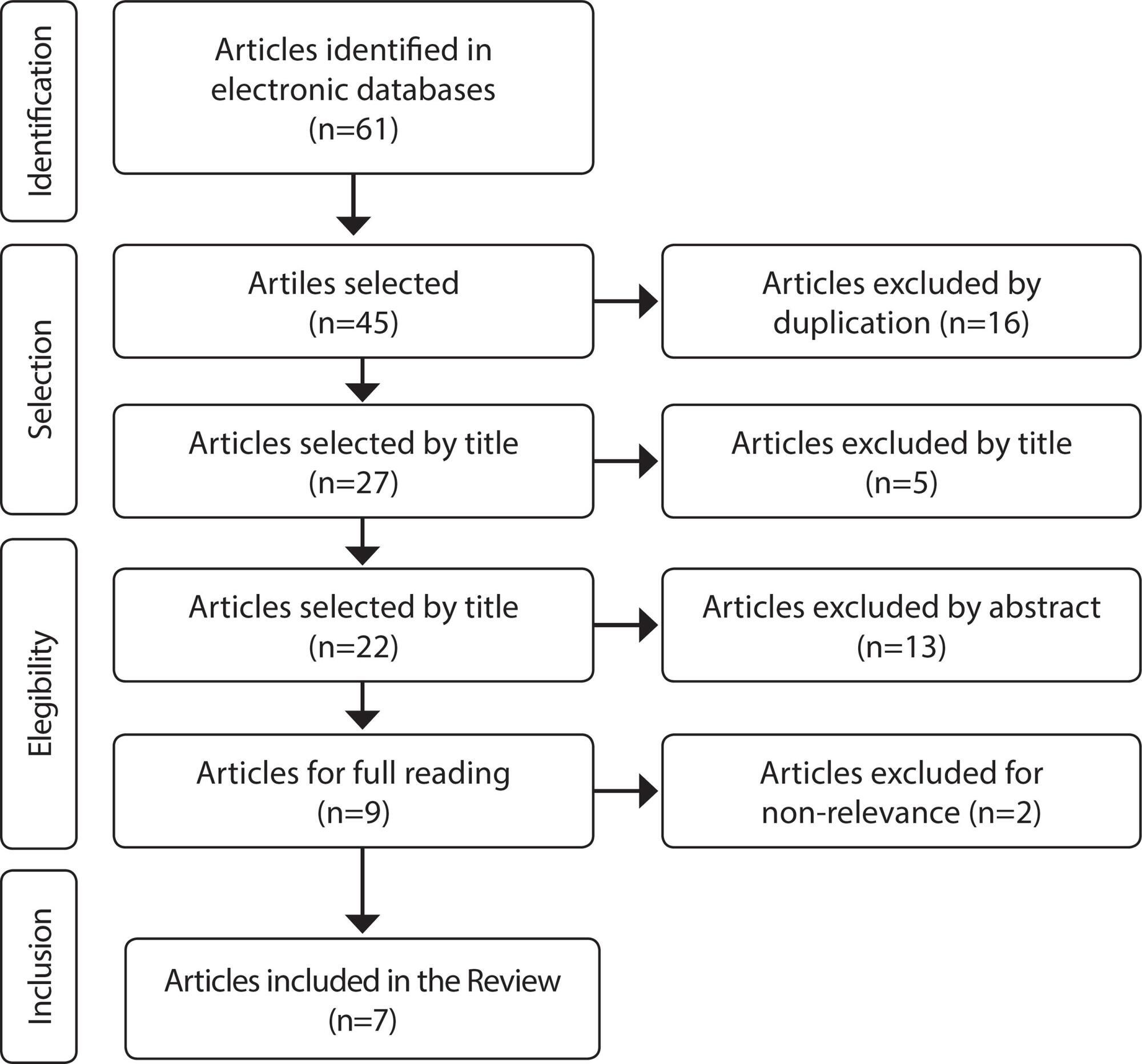
-
REFLECTION12-13-2019
Women with fetal death: nurses’ care limitations
Revista Brasileira de Enfermagem. 2019;72:365-368
Abstract
REFLECTIONWomen with fetal death: nurses’ care limitations
Revista Brasileira de Enfermagem. 2019;72:365-368
DOI 10.1590/0034-7167-2018-0261
Views0See moreABSTRACT
Objective:
To present the limitations of the nursing care for women with fetal death, reflecting on this challenge for care practices.
Method:
Reflective study with theoretical focus on national and international publications, along with the experience of the authors in the area of women’s health and obstetrics.
Results:
There are limitations related to nursing care, which involve feelings of insecurity and powerlessness, inappropriate attitudes of these professionals in front of women, difficulties to manage emotional aspects, and structural problems of health services.
Final Considerations:
This study points out that there are challenges to qualify nursing care for women with fetal death, which included academic studies and continuing education in health services. Relational aspects should be valued and demand more sensitivity from nurses, with more empathic relationships in the care for women with fetal death.
-
REVIEW10-07-2022
Strategies for thirst management in postoperative adult patients: a scoping review
Revista Brasileira de Enfermagem. 2022;75(4):e20220154
Abstract
REVIEWStrategies for thirst management in postoperative adult patients: a scoping review
Revista Brasileira de Enfermagem. 2022;75(4):e20220154
DOI 10.1590/0034-7167-2022-0154
Views0See moreABSTRACT
Objectives:
to map the strategies for managing thirst in postoperative adult patients.
Methods:
scoping review was conducted in October 2021 in 19 data sources: 14 databases and 5 platforms to search in the grey literature. It was prepared according to the recommendations of the Joanna Briggs Institute and the checklist of the Preferred Reporting Items for Systematic reviews and Meta-Analyses extension for Scoping Reviews. Nine selected articles were part of the final sample.
Results:
there is evidence of strategies to manage postoperative thirst using interventions such as water, ice, mentholated measures, carbohydrate and protein enriched fluid, oral hydrator, flavored gargling, cold gargling, wet gauze, 0.75% citric acid spray, and cold water.
Final Considerations:
the strategies observed may be reduced to cold and menthol use, salivary stimulants, and early introduction of fluids. The outcomes were positive in all the studies reviewed.
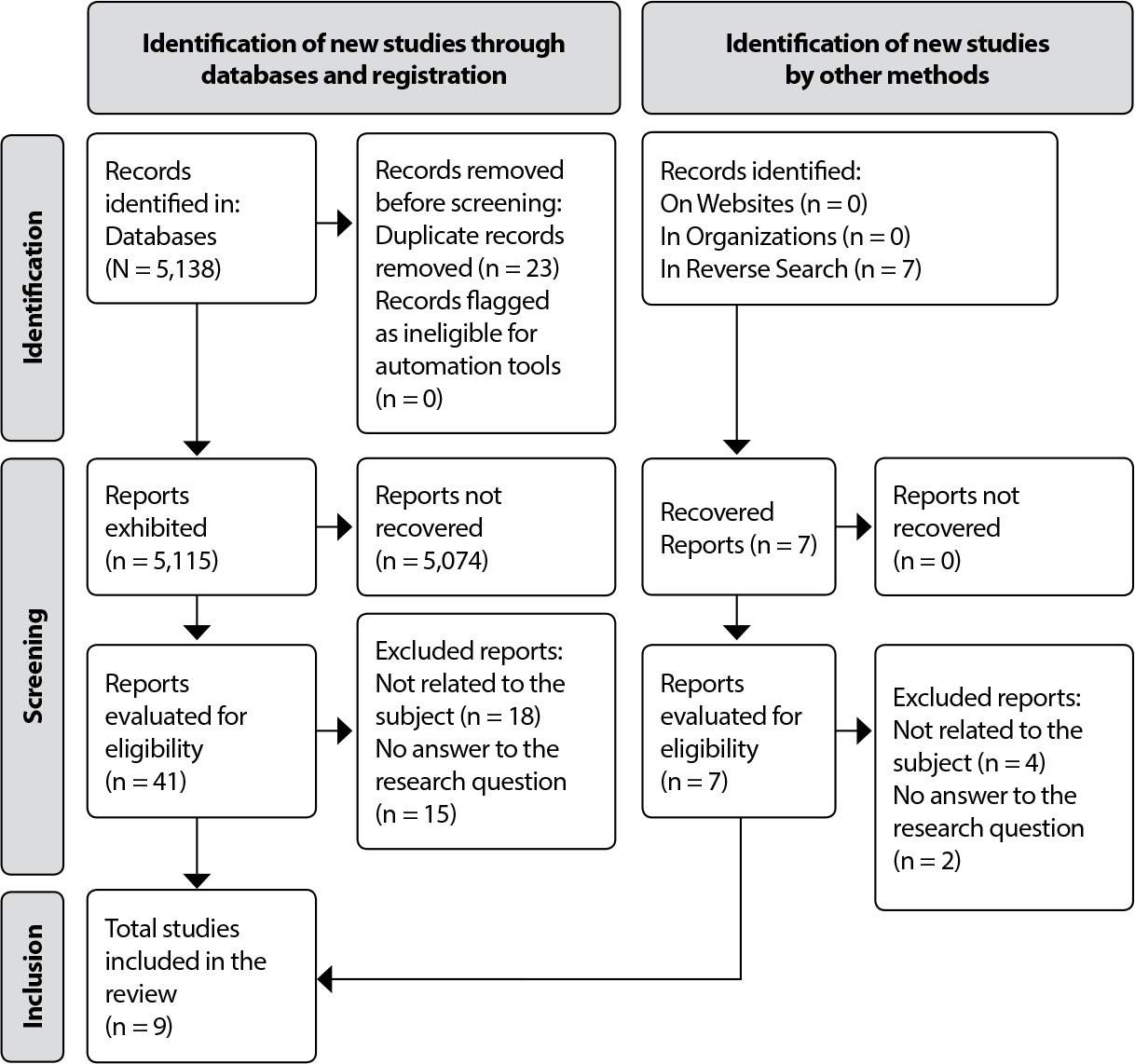
Search
Search in:
Nuvem de Tags
Adolescente (85) Atenção Primária à Saúde (239) COVID-19 (91) Criança (91) Cuidados de Enfermagem (269) Educação em Enfermagem (151) Educação em Saúde (139) Enfermagem (930) Enfermagem Pediátrica (86) Estudantes de Enfermagem (77) Estudos de Validação (131) Família (87) Idoso (208) Promoção da Saúde (99) Qualidade de Vida (104) Saúde do Trabalhador (86) Saúde Mental (145) Saúde Pública (82) Segurança do Paciente (150) Tecnologia Educacional (100)



